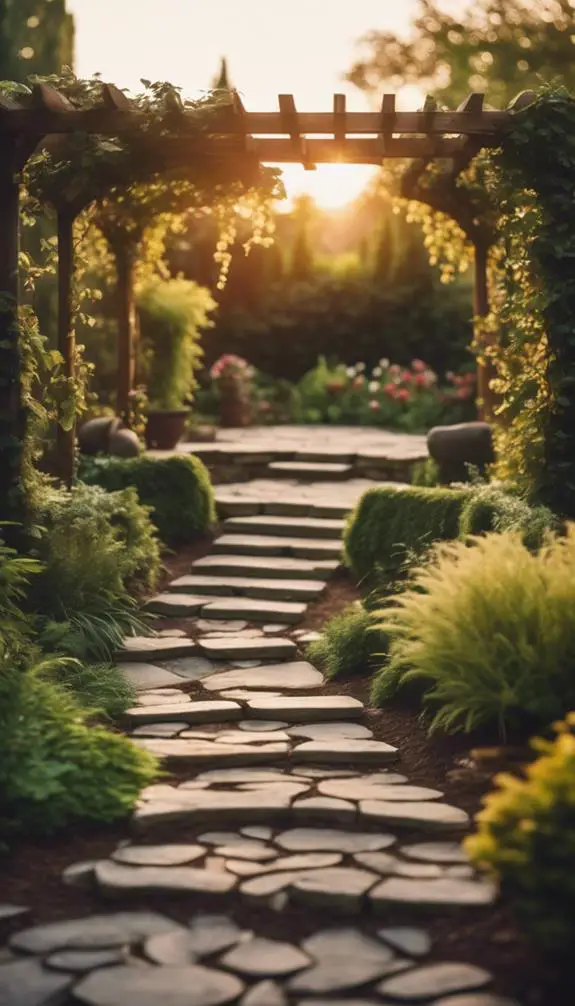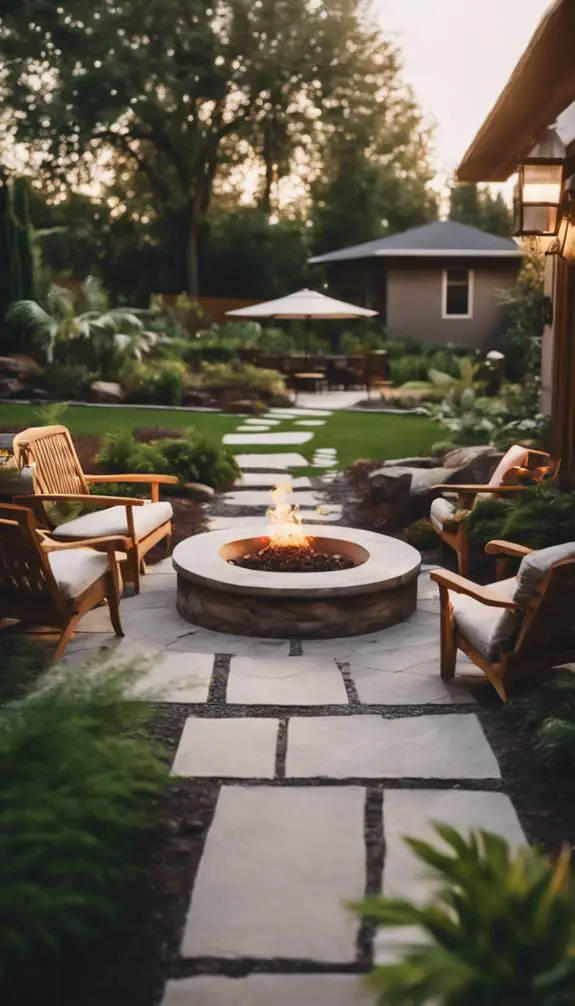As you stand in your rectangular backyard, you're likely thinking, "What can I do with this space?" With its clean lines and defined boundaries, a rectangular yard offers endless possibilities. You'll want to start by evaluating your yard's dimensions, identifying any obstructions, and determining how to create a sense of symmetry. But where do you go from there? How can you balance the length and width to create functional zones for entertainment, relaxation, and recreation? The answers to these questions will set the stage for a backyard design that's both beautiful and functional – and we're about to explore them.
Summary
- Measure the yard accurately to determine total square footage and identify obstructions or irregularities.
- Create a focal point with a statement piece, such as a sculpture or water feature, to anchor the space and create symmetry.
- Divide the rectangular backyard into multiple zones, each serving a specific purpose, using clear boundaries and features like paths or hedges.
- Incorporate curves and angles to soften sharp corners, add visual interest, and create a sense of harmony and visual appeal.
- Strategically place lighting and water features to guide guests, highlight design elements, and create a visually appealing atmosphere.
Assessing Your Yard's Dimensions
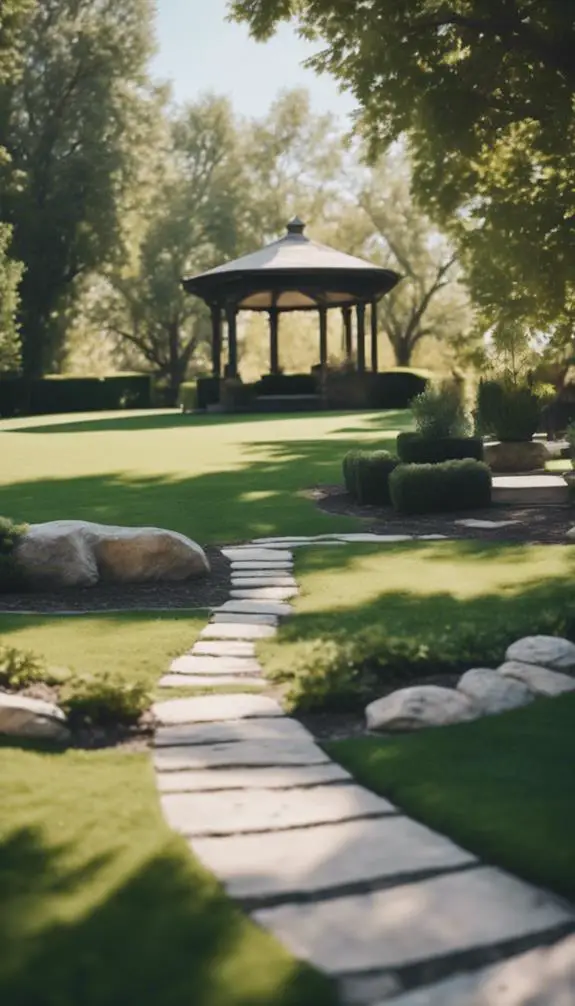
Measure your yard's length and width to determine the total square footage. This calculation provides the foundation for your rectangular backyard design.
Use a tape measure or laser distance meter to record the dimensions, taking note of any obstructions or irregularities.
Perform dimension analysis to identify the yard's aspect ratio, which will influence your design decisions. Consider the proportions of the space, ensuring your design complements the yard's natural shape.
Accurate yard measurement is vital, as it will impact the functionality and aesthetic of your outdoor area. By understanding your yard's dimensions, you'll be able to create a harmonious and functional rectangular backyard design that maximizes space and enhances your outdoor living experience.
Creating a Focal Point
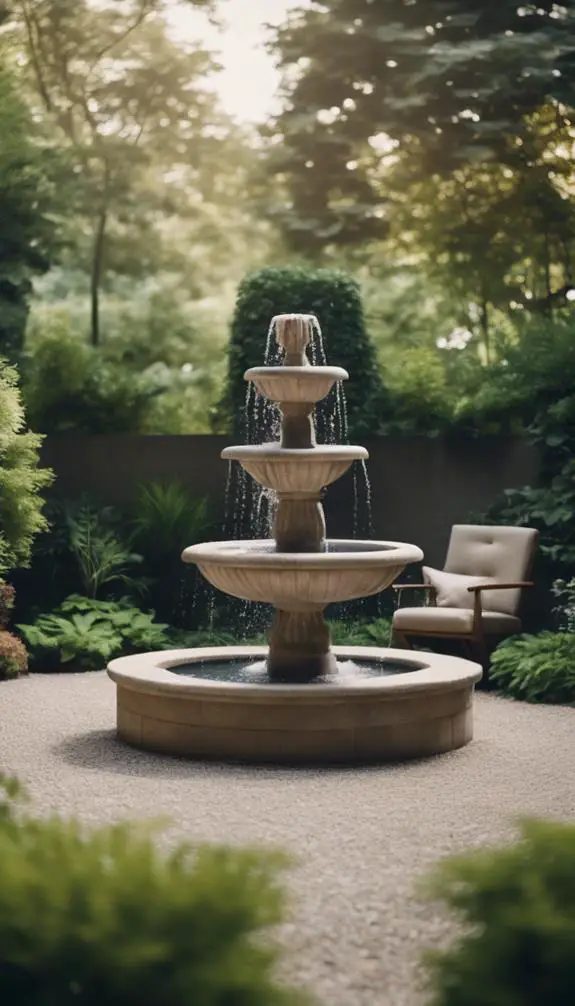
As you design your rectangular backyard, you'll want to create a focal point that draws the eye and anchors the space.
This centerpiece of the yard can be a statement piece, such as a sculpture or water feature, that commands attention.
Centerpiece of the Yard
A well-designed centerpiece anchors the entire yard, drawing the eye to a specific area and creating visual balance.
As you plan your rectangular backyard design, consider a statement piece that serves as the focal point. This could be a stunning yard ornament, such as a modern sculpture or a large planter, that adds personality to your outdoor space.
Strategically place your centerpiece to create a sense of symmetry, using it to divide the yard into distinct areas or zones. By doing so, you'll create a visually appealing space that invites relaxation and entertainment.
Choose a piece that reflects your personal style, and don't be afraid to experiment with unique materials or textures to make your centerpiece truly stand out.
Visual Interest Points
When designing your rectangular backyard, incorporate visual interest points to draw the eye to specific areas, creating a dynamic flow throughout the space.
These points create a visual focal point, guiding visitors through your outdoor space. To create visual interest, use decorative accents like statement planters, sculptures, or water features.
Strategically place these elements to create balance and harmony. Consider the rule of thirds, dividing your yard into thirds both horizontally and vertically, and place visual interest points at these intersections.
This technique creates a sense of movement and energy, drawing the eye to specific areas of your yard. By incorporating visual interest points, you'll create a mesmerizing and dynamic rectangular backyard design.
Zone Divisions for Functionality
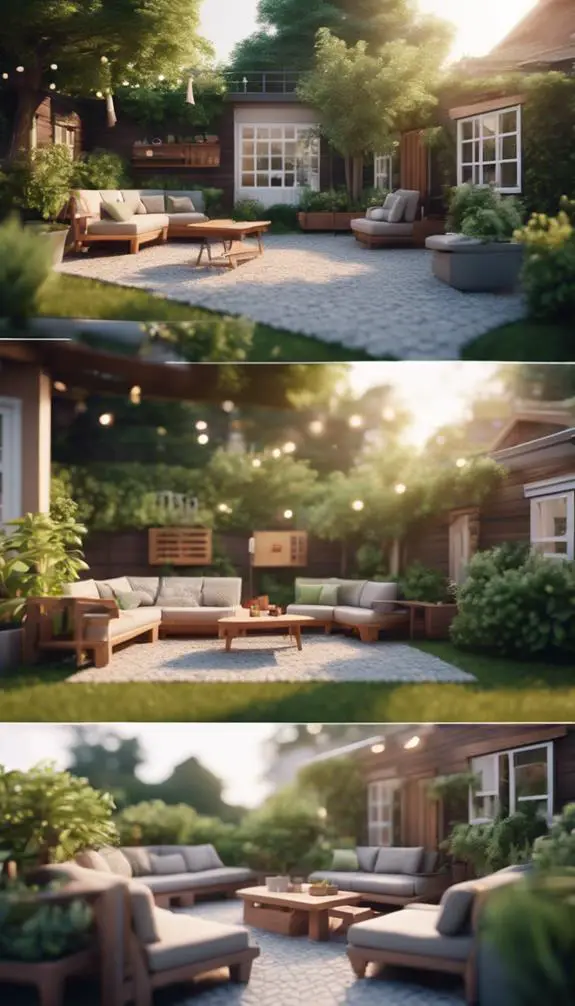
Every rectangular backyard can be divided into multiple zones, each serving a specific purpose to enhance functionality and overall appeal.
You'll want to define these zones with clear boundaries, using features like paths, hedges, or screens to separate one area from another. This will create functional areas that flow seamlessly into one another, making the most of your outdoor space.
Consider dedicating zones to entertainment, relaxation, and recreation, such as a dining area, reading nook, or play zone. By dividing your backyard into distinct zones, you'll create an efficient and enjoyable outdoor living space that suits your lifestyle.
Balancing Length and Width
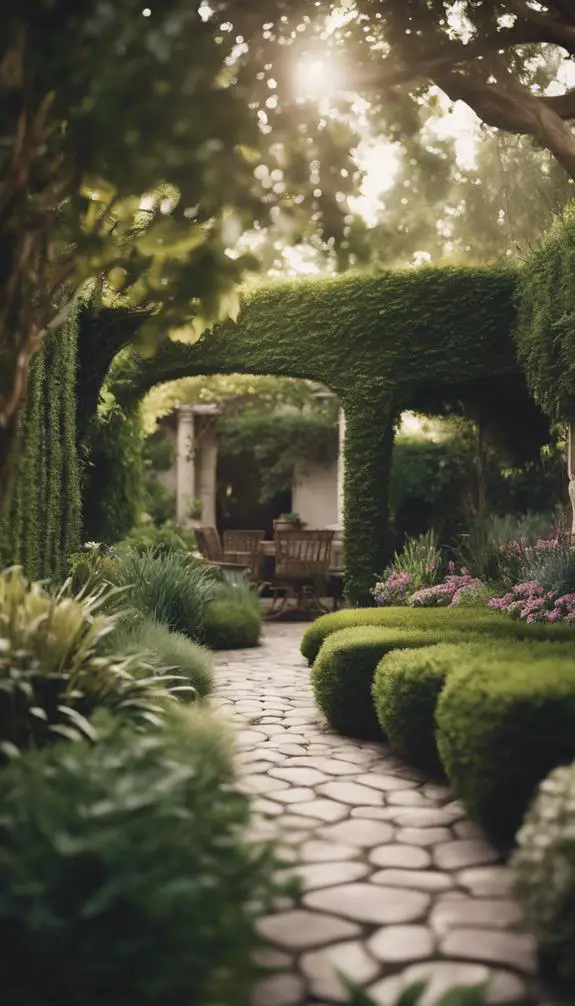
Your rectangular backyard's proportions play a crucial role in its overall aesthetic and functionality.
Length proportions can create a sense of grandeur, but if they're too exaggerated, the space can feel narrow and claustrophobic.
On the other hand, width challenges can make the area feel cramped and divided.
To strike a balance, consider the Golden Ratio (1:1.6) as a starting point for your design.
This proportion creates a sense of harmony and visual appeal.
You can then adjust the ratio to suit your specific needs and style.
Incorporating Curves and Angles
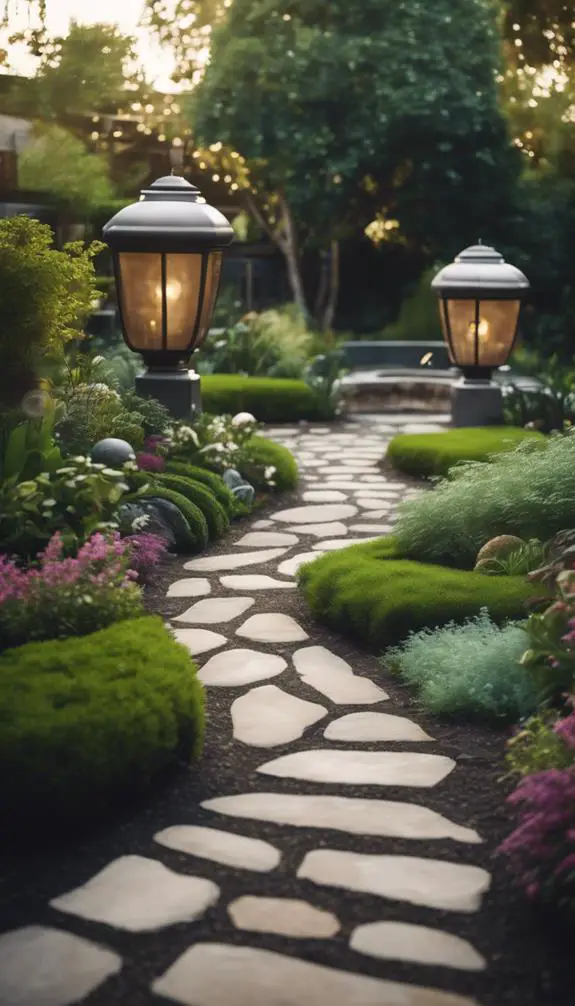
You can soften the sharp corners of your rectangular backyard design by incorporating subtle curves, creating a more visually appealing contrast to the rigid lines.
Softening Sharp Corners
Sharp corners can create a sense of rigidity in a rectangular backyard, making it feel more like a box than an inviting outdoor space.
To soften these corners, you'll need to incorporate curves and angles that visually break up the rectangular shape. One effective corner solution is to create a curved border around the perimeter of your yard, using plants or hardscaping materials like stone or brick.
This will help to blur the sharp edges and create a more fluid, organic feel. Another approach is to use corner landscaping to add visual interest, such as a decorative planter or a statuesque tree.
Embracing Geometric Shapes
The rectangular backyard's rigid geometry can be tempered by incorporating curves and angles, which introduce a sense of dynamism and visual interest.
You can create geometric patterns by combining straight lines with curved elements, like circular patios or sinuous walkways.
Shape manipulation is key to adding depth and complexity to your design.
Try using contrasting shapes, like pairing rounded planters with angular benches, to create visual tension.
You can also experiment with fragmented shapes, like dividing a rectangular patio into smaller, curved sections.
Selecting the Right Hardscape
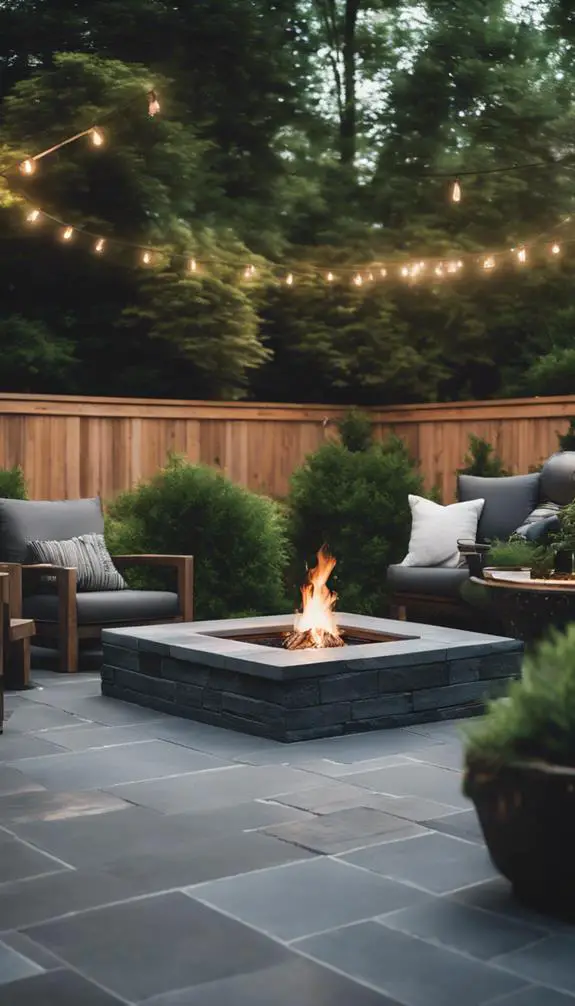
Every rectangular backyard design hinges on a well-chosen hardscape, which sets the tone for the entire outdoor space.
When selecting materials, consider the style and functionality you want to achieve. Natural stone, porcelain pavers, and concrete are popular options, each offering unique textures and colors.
Think about durability, maintenance, and slip resistance when making your decision. To add visual interest, incorporate pattern variation through the use of different shapes, sizes, and layouts.
A combination of linear and geometric patterns can create a dynamic, modern look. Consider the scale of your space and balance large format pavers with smaller accents to achieve visual harmony.
Planting for Visual Interest
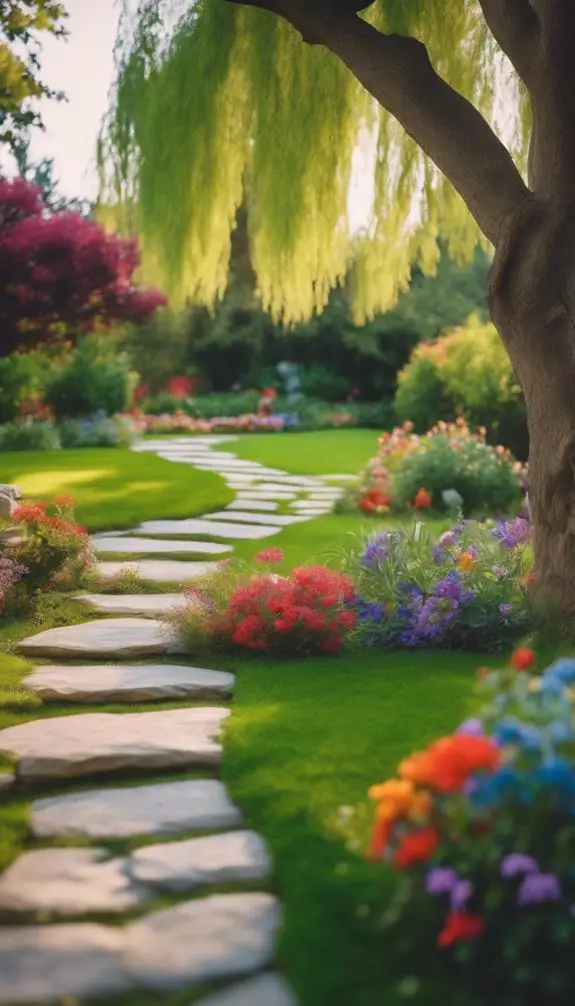
With a solid hardscape foundation in place, you're ready to inject life and visual interest into your rectangular backyard design through strategic planting.
To create a visually striking landscape, employ botanical contrast by combining plants with varying textures, forms, and growth habits. For example, pair smooth-leaved shrubs with plants featuring feathery or spiky foliage.
Color blocking is another effective technique to add visual interest. Divide your plant palette into distinct color groups, such as cool blues and whites or warm yellows and oranges, to create a cohesive and dynamic look.
Adding Vertical Elements
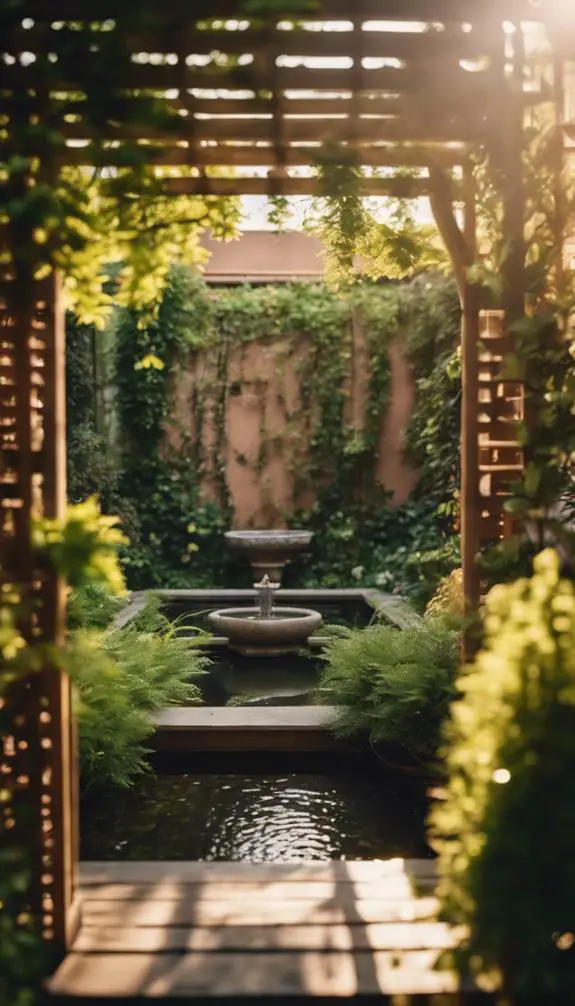
Break up the flat plane of your rectangular backyard design by incorporating vertical elements that draw the eye upward and create a sense of depth.
Vertical accents like trellises, arbors, or obelisks can add visual interest and create a sense of layering. Consider installing green walls or living screens to bring in a touch of nature and soften the rectangular shape.
These features can also help block views, create shade, or define different areas within your yard. By incorporating vertical elements, you can create a more dynamic and engaging outdoor space that draws the eye upward and invites exploration.
Outdoor Room Design Ideas

As you design your outdoor room, consider creating cozy corner spaces that invite relaxation, where built-in benches and lush greenery converge to form an intimate atmosphere.
You can also incorporate private seating areas, defined by strategically placed planters or screens, to provide a sense of seclusion within your rectangular backyard.
Cozy Corner Spaces
Create a sense of seclusion by tucking a cozy corner space into the rectangular backyard's most sheltered nook.
You can define this intimate area with a trellis or a pergola, training vines or flowers to grow overhead and filter the sunlight.
Incorporate comfortable seating, like a plush sectional sofa or a hammock, and add a side table or a fire pit to create a warm ambiance.
To enhance the sense of seclusion, consider adding a water feature, like a small fountain or a birdbath, which will also attract wildlife.
Private Seating Areas
By incorporating private seating areas into your rectangular backyard design, you can section off intimate spaces that invite conversation and connection.
These secluded nooks can be designed to provide quiet escapes from the rest of the yard, perfect for reading a book or enjoying a morning coffee.
Consider using natural barriers like hedges or trees to create a sense of enclosure, or incorporate built-in seating like benches or daybeds to define the space.
Add some ambient lighting and lush greenery to create a cozy atmosphere, and you'll have a private retreat that's perfect for relaxation.
Lighting for Ambiance and Safety
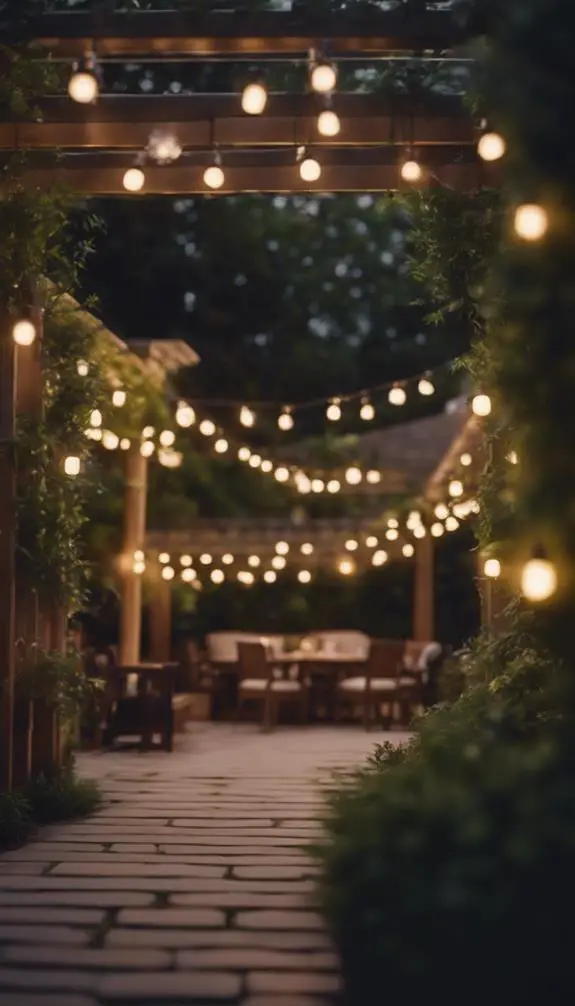
Frequently, homeowners overlook the significance of outdoor lighting, yet it's a crucial aspect of creating a functional and inviting rectangular backyard.
You'll want to strategically place pathway lighting to guide guests through your outdoor space, ensuring safety and accessibility. Ambient pools of light can be achieved by using spotlights or uplights to highlight specific design elements, such as water features or sculptures.
By layering different light sources, you can create a visually appealing atmosphere that's both functional and inviting. Consider using energy-efficient LED lights or smart lighting systems to enhance your outdoor space while reducing energy consumption.
With thoughtful lighting design, you'll be able to enjoy your backyard oasis long after the sun sets.
Water Feature Incorporation

A serene rectangular backyard often features a visually striking water element, which can elevate the ambiance and provide a sense of tranquility.
When incorporating a water feature, consider the water flow's visual and auditory impact. A small pond or fountain can create a soothing atmosphere, while a larger pool integrates seamlessly into the rectangular design.
Pool integration allows for a cohesive look, as the water's edge can be designed to blend with the surrounding landscape.
To maximize visual appeal, position the water feature in a way that creates a sense of symmetry or balance within the yard. By thoughtfully incorporating a water element, you can create a unique and enchanting rectangular backyard design.
Maintaining a Rectangular Yard

As you've successfully incorporated a water feature into your rectangular backyard design, now it's time to think about the upkeep.
Yard maintenance is vital to preserve the beauty and functionality of your outdoor space.
Regular lawn care is essential, including mowing, edging, and watering to keep your grass healthy and vibrant.
You'll also need to prune plants, clean the water feature, and inspect the surrounding hardscapes for damage.
Set aside time each week to perform these tasks, and consider investing in automated systems, like irrigation controllers, to simplify the process.
FAQs
Can I Have a Rectangular Backyard With a Sloping Terrain?
You can definitely work with a sloping terrain, but you'll need to weigh grading options to manage elevation changes, ensuring a stable and functional space that flows seamlessly, whether you're creating a rectangular backyard or not.
How Do I Handle a Rectangular Yard With Existing Mature Trees?
When working with existing mature trees, you'll want to assess tree placement and yard proportions to create a harmonious balance. Consider the trees' canopy spread and root systems, then design around them, incorporating curved paths and tiered planting to create a visually stunning landscape.
Are There Any Specific Design Rules for Small Rectangular Backyards?
When designing a small yard, you'll want to contemplate a zone layout to maximize space, and strategically create borders to define areas, like a seating zone or veggie garden, while maintaining a visually appealing flow.
Can I Incorporate a Fire Pit Into a Rectangular Backyard Design?
When incorporating a fire pit, you'll want to ponder Fire Pit Placement, situating it at least 10 feet from flammable structures, and prioritize Pit Safety by creating a clear perimeter and using heat-resistant materials to guarantee a cozy, safe gathering spot.
Are There Any Eco-Friendly Materials for Hardscaping a Rectangular Yard?
You'll find eco-friendly hardscaping options abound; consider permeable pavers, allowing rainwater to percolate, and sustainable stone, sourced locally to reduce carbon footprint, both blending seamlessly into your outdoor space while promoting environmental harmony.
Conclusion
You've successfully designed a rectangular backyard that's both functional and visually appealing. By evaluating your yard's dimensions, creating a focal point, and dividing the space into zones, you've created a harmonious balance of length and width. Incorporating curves, angles, and geometric patterns adds visual interest, while outdoor rooms, ambient lighting, and water features enhance the ambiance. With proper maintenance, your rectangular backyard will remain a tranquil retreat for years to come.



